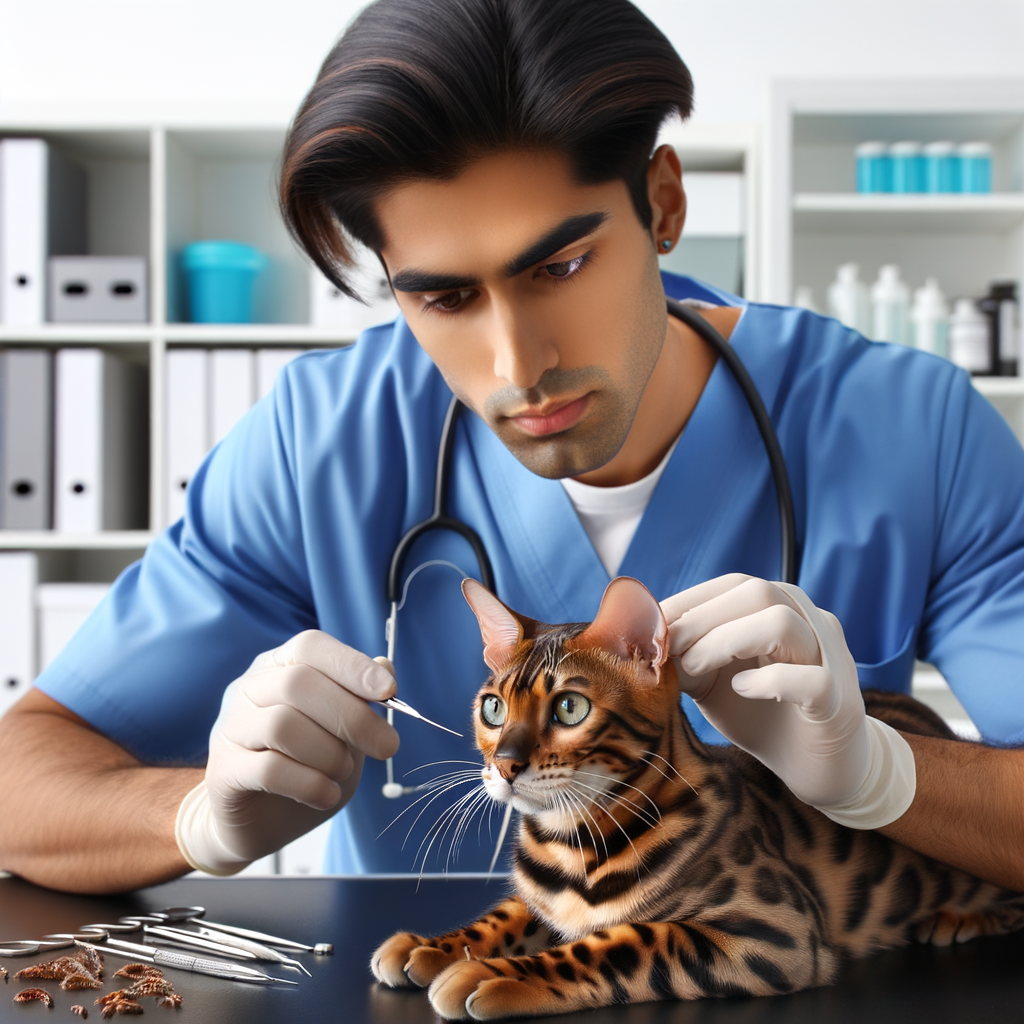
Introduction: Bengal Cat Health & Parasites
- Overview of Bengal Cat HealthThey are generally healthy, but like all pets, they need proper care to stay that way. Regular vet visits, a balanced diet, and plenty of exercise are key to keeping your Bengal cat healthy.
- Common Bengal Cat Parasites and Their Impact on HealthCommon parasites include fleas, ticks, and worms. These parasites can cause various health problems, such as itching, weight loss, and even serious diseases. Recognize the signs of parasites and take action quickly.
Identifying Bengal Cat Parasites
Common Bengal Cat Parasites
These parasites can cause various health issues if not treated promptly. Here are some of the most common parasites found in Bengal cats:
- Worms: One of the most common parasites in cats. They can live in the intestines and cause problems like weight loss and diarrhea. Types of worms include roundworms, tapeworms, and hookworms.
- Fleas: Tiny insects that live on your cat’s skin and feed on their blood. They can cause itching, skin infections, and even anemia in severe cases. Fleas can also carry tapeworms.
- Ticks: Small arachnids that attach to your cat’s skin and feed on their blood. They can transmit diseases like Lyme disease and cause skin irritation.
- Intestinal parasites: Besides worms, other intestinal parasites like Giardia and Coccidia can infect your cat. These parasites can cause diarrhea, vomiting, and weight loss.
Bengal Cat Parasite Symptoms
-
Changes in appetite:
They might eat more or less than usual. If you notice your cat is suddenly very hungry or not interested in food, it could be a sign of a parasite.
-
Weight loss:
Even if your Bengal cat is eating normally, parasites can cause them to lose weight. This is because the parasites take nutrients from the cat’s body. Keep an eye on your cat’s weight and consult a vet if you see any unexplained weight loss.
-
Changes in behavior:
Parasites can make your Bengal cat feel very uncomfortable. They might become more irritable or less active. You might also see them scratching or grooming themselves more often. These changes in behavior can be a sign that something is wrong.
-
Visible parasites in fur or feces:
Sometimes, you can actually see the parasites. Look for small, moving creatures in your cat’s fur or tiny white segments in their feces. If you see anything unusual, take your cat to the vet right away.
Treating Bengal Cat Parasites
Bengal Cat Worm Treatment
-
Identifying the type of worm:
Common worms in Bengal cats include roundworms, tapeworms, and hookworms. Look for signs like weight loss, vomiting, or a bloated belly. A visit to the vet can confirm the type of worm.
-
Choosing the right medication:
Once you know the type of worm, you can choose the right medication. Your vet might recommend a dewormer like pyrantel pamoate for roundworms or praziquantel for tapeworms. Always follow the vet’s instructions for dosage and duration.
-
Preventing re-infestation:
Regularly clean your cat’s litter box and keep their living area tidy. Also, consider regular deworming treatments as recommended by your vet.
Bengal Cat Flea Prevention
-
Regular grooming:
Brushing your cat’s fur helps remove any fleas and their eggs. It also gives you a chance to check for any signs of fleas, such as small black specks or flea dirt. Aim to groom your Bengal cat at least once a week.
-
Using flea prevention products:
There are various flea prevention products available, such as flea collars, topical treatments, and oral medications. These products are designed to kill fleas and prevent them from coming back. Always consult your vet to choose the best product for your Bengal cat. According to a study, flea prevention products can reduce flea infestations by up to 95%.
-
Maintaining a clean living environment:
Vacuum your carpets, furniture, and your cat’s bedding regularly. Wash your cat’s bedding in hot water to kill any fleas and their eggs. A clean environment makes it harder for fleas to thrive.
| Prevention Method | Frequency | Benefits |
|---|---|---|
| Regular grooming | Weekly | Removes fleas and eggs, early detection |
| Flea prevention products | Monthly | Kills and prevents fleas |
| Clean living environment | Weekly | Reduces flea habitat |
Bengal Cat Tick Removal
-
Safe removal techniques
- Use fine-tipped tweezers to grasp the tick as close to the skin’s surface as possible.
- Pull upward with steady, even pressure. Do not twist or jerk the tick; this can cause parts of it to break off and remain in the skin.
- After removing the tick, thoroughly clean the bite area and your hands with rubbing alcohol or soap and water.
- Dispose of the tick by submersing it in alcohol, placing it in a sealed bag/container, wrapping it tightly in tape, or flushing it down the toilet. Never crush a tick with your fingers.
-
When to seek veterinary assistance
- If you cannot remove the tick completely.
- If the bite area looks infected (red, swollen, or oozing pus).
- If your cat shows signs of illness, such as fever, loss of appetite, or lethargy.
Treating Bengal Cat Intestinal Parasites
- Identifying the parasiteCommon intestinal parasites include roundworms, tapeworms, and hookworms. You might notice symptoms like diarrhea, vomiting, or a bloated belly. A visit to the vet can confirm the type of parasite through a fecal exam.
- Choosing the right treatmentThis often involves deworming medications. Make sure to follow the vet’s instructions carefully. Some treatments might need to be repeated to ensure all parasites are gone.
- Preventing future infestationsKeep your Bengal cat’s living area clean and dispose of feces promptly. Regular vet check-ups and preventive medications can also help. Feeding your cat a balanced diet and ensuring they don’t eat raw meat or hunt small animals can reduce the risk of parasites.
Bengal Cat Deworming
- Importance of Regular Deworming
Worms can cause serious problems like weight loss, diarrhea, and even organ damage. By deworming your cat regularly, you can prevent these issues and keep your cat happy and healthy.
- Choosing the Right Deworming Product
Choose a product that targets the specific types of worms your cat might have. Always consult your vet to find the best product for your Bengal cat.
- Administering Deworming Medication
Some medications come in pill form, while others are liquids or topical treatments. Follow the instructions on the package carefully, and if you’re unsure, ask your vet for help. Make sure your cat gets the full dose to ensure the treatment is effective.
| Type of Worm | Symptoms | Recommended Treatment |
|---|---|---|
| Roundworms | Weight loss, diarrhea | Pyrantel pamoate |
| Tapeworms | Segments in stool, scooting | Praziquantel |
| Hookworms | Anemia, bloody stool | Fenbendazole |
Bengal Cat Parasite Control
-
Regular vet check-ups:
Taking your Bengal cat to the vet regularly helps catch any parasites early. Vets can also provide treatments to prevent parasites.
-
Proper grooming and hygiene:
Regular grooming keeps your Bengal cat clean and healthy. Brushing their fur and cleaning their ears can prevent parasites from taking hold.
-
Keeping indoor environments clean:
A clean home reduces the risk of parasites. Vacuum often, wash your cat’s bedding, and keep their litter box clean.
Maintaining Your Bengal Cat’s Health
Regular health checks, a good diet, and exercise can help. Let’s look at some key points.
-
Importance of regular health checks:
This helps your cat stay healthy. Check-ups can find issues like parasites before they become serious.
-
Role of diet and exercise in preventing parasites:
Healthy cats are less likely to get parasites. Make sure your cat eats high-quality food and gets plenty of playtime.
-
Keeping your Bengal cat happy and healthy:
Spend time with your Bengal cat. Play with them and give them attention. This helps them stay active and reduces stress, which can prevent health problems.
By following these tips, you can help your Bengal cat live a long, healthy life. Regular vet visits, a good diet, and lots of exercise are key. Keep your cat happy and healthy, and they will be your loving companion for years to come.






